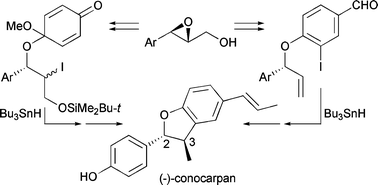Synthesis of (−)-conocarpan by two routes based on radical cyclization and establishment of its absolute configuration†
Abstract
Two independent routes for the total synthesis of the bioactive

* Corresponding authors
a
Chemistry Department, University of Alberta, Alberta T6G 2G2, Edmonton, Canada
E-mail:
derrick.clive@ualberta.ca
Two independent routes for the total synthesis of the bioactive

 Please wait while we load your content...
Something went wrong. Try again?
Please wait while we load your content...
Something went wrong. Try again?
D. L. J. Clive and E. J. L. Stoffman, Org. Biomol. Chem., 2008, 6, 1831 DOI: 10.1039/B801858H
To request permission to reproduce material from this article, please go to the Copyright Clearance Center request page.
If you are an author contributing to an RSC publication, you do not need to request permission provided correct acknowledgement is given.
If you are the author of this article, you do not need to request permission to reproduce figures and diagrams provided correct acknowledgement is given. If you want to reproduce the whole article in a third-party publication (excluding your thesis/dissertation for which permission is not required) please go to the Copyright Clearance Center request page.
Read more about how to correctly acknowledge RSC content.
 Fetching data from CrossRef.
Fetching data from CrossRef.
This may take some time to load.
Loading related content
